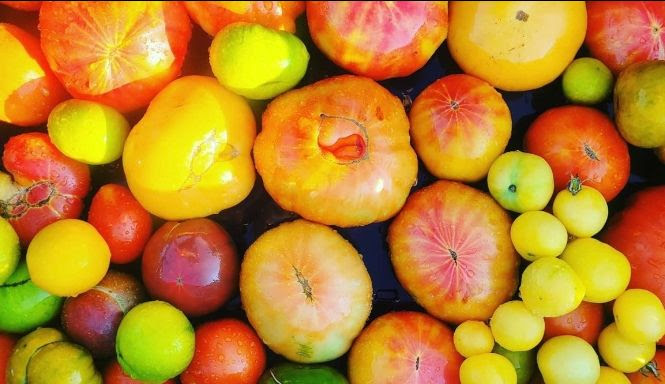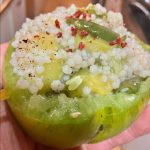Excerpt from Ari’s Top 5 enews
You can make this tomato sauce in your own kitchen in as few as 15 minutes!
When August arrives, it marks the start of the six to eight weeks out of each year in Ann Arbor that we have amazing tomatoes to enjoy. I’m particularly fortunate because Tammie grows incredibly delicious heirlooms at Tamchop Farm. While most of them get sold to the Roadhouse, Deli, Miss Kim, Bellflower, and other restaurants around town, we also get to eat them every night at our house! If you grow them in your garden at home, I’m guessing you have a similar experience. You can find great heirloom tomatoes at the farmers market or Argus Farm Stop as well.
This time of year, we use tomatoes in pretty much every meal, and one of our regular recipes is to make fresh tomato sauce. It’s seriously one of the simplest things you can make. The first step is to buy—or grow—great tomatoes. Put some extra virgin olive oil in a medium saucepan, or big sauté pan, and turn the heat to medium. When the oil is hot (but well before it starts to smoke) you can add a clove or two of garlic that’s been peeled and then lightly bruised. Cook lightly until the aroma fills the room, but don’t brown. Cut your tomatoes into large chunks, then add them to the pan along with a bit of sea salt. We add a piece of rind from Parmigiano Reggiano. Stir gently, bring to a light boil, reduce the heat, and simmer for about 10-20 minutes. The tomato sauce may seem a bit watery, but in my experience, the liquid will be absorbed into the pasta, so don’t panic.
Meanwhile, bring a big pot of sea-salted water to a boil. While the pasta is cooking, warm a few bowls with the pasta-cooking water. Stir the pasta now and again so it doesn’t stick, and stir the sauce as well. Add a small bit of the pasta-cooking water to the tomatoes to help thicken the sauce just a touch. When the pasta is very al dente, drain it and then add it immediately to the sauce. Stir gently and cook for a couple more minutes. I like to add some grated Parmigiano Reggiano or Pecorino Romano to the pan along with a few leaves of fresh basil. Cook for a few minutes—the sauce will integrate into the pasta.
The dish is so simple that you will absolutely want to make it with world-class pasta. I like something rounder, squatter and, shall I say, scoopier, that will hold a bit of the sauce inside its cupped shape. One really lovely option you might consider is the Gnochetti Napoletani from the Zampino family in blue bags labeled Pasta Gentile. The pastificio was started in 1876, four years before Bonajuto began hand-crafting chocolate in southeastern Sicily, in an era when dried pasta was still a seasonal product. Pasta secche of this sort was made solely from late spring into early autumn when it could be properly dried in the open air and the sun. Walking through the town of Gragnano in the late 19th and early 20th centuries, one would have passed, on either side of the road, countless racks of drying pasta in the sun and open air. The magazine Le Sirenuse writes:
As for the wind, it was the perfect drying agent: blowing constantly down the main street, almost always in the same direction, it had (most days) just the right level of humidity. The drying process was helped by the dark volcanic paving stones of Gragnano’s streets, which radiated the sun’s heat even after dark.
Open air drying like this is not just an affectation—it’s been shown to alter the texture and flavor of the products for the better. Gentile is the only pasta maker I know of in Italy that still dries in a way that allows open air to circulate through the room. (The Mahjoub family’s incredible hand-rolled couscous from Tunisia is still sun-dried. You really can taste the difference!) Their terrifically old-school process—which was modern at the time they started using it—is known as the Cirillo method, after Michele Cirillo who invented it. It takes three to three-and-a-half days to dry the pasta this way, compared to six to eight hours in an industrial setting.
Serve in the warm bowls. Drizzle a ribbon of your favorite extra virgin olive oil on top, and, if you like, add a little more grated cheese or some red pepper flakes.




